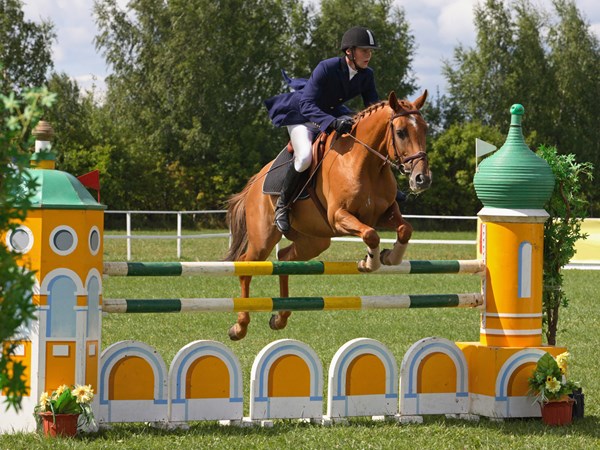 Credit: Thinkstock Nutrient and energy imbalances in athletic horses can manifest as chronic fatigue and other signs associated with overtraining syndrome.
Credit: Thinkstock Nutrient and energy imbalances in athletic horses can manifest as chronic fatigue and other signs associated with overtraining syndrome.In the wild, horses spend the bulk of each day grazing, picking and choosing what they will consume to balance out their own diet. Domesticated horses, on the other hand, are at the mercy of their owners or caregivers, which means the composition of the ration, feeding schedule, and feeding technique can be highly variable.
“Nutrient and energy imbalances in athletic horses can manifest as chronic fatigue and other signs associated with overtraining syndrome,” explained Kathleen Crandell, PhD, an equine nutritionist at Kentucky Equine Research in Versailles, Kentucky.
Show jumpers and other sport horses required to undergo intermittent bouts of sprinting during competition have a higher demand for a molecule called adenosine triphosphate (ATP) than horses competing at constant speeds. ATP is the key molecule for providing energy to every cell in the body. Research suggests that diet composition and timing of feeding can impact performance through ATP, insulin and fat levels in the blood.
Researchers analyzed* the diets of 20 jumpers and compared them to diet recommendations from published literature to provide new insights into common feeding practices and their effects on show-jumping horses. In addition, the blood levels of various molecules important to exercise (e.g., lactate, fat, insulin, sugar) were measured before and after exercise in 27 jumpers at 71 events.
The results of the feeding questionnaire revealed that, on average, the diets of show jumpers included:
- 6.9 kg (15.2 lb) of roughage per day;
- 3.1 kg (6.8 lb) of concentrates fed in 2 or 3 meals per day;
- On average, the last meal was fed 6 hours, 10 minutes before the start of the first round; and
- 7 horses (35%) had access to hay and water between two performances.
Contrary to some information in the literature suggesting that a starch-rich (or sugar-rich) diet better supports horses participating in short, intensive work like show jumping, researchers on this study did not support such a diet. Specifically, the current study found that jumpers profited from feeding roughage 2 to 4 hours prior to exercise and that feeding concentrates did not have any important influence on blood analyses.
“Based on the information in the article, it was not clear if the concentrates fed were actually ‘starch-laden.’ It is also important to note that horses were mostly fed well in advance of the work effort (on average, 6 hours and 10 minutes before the start of the first show jumping performance), which falls well into KER’s recommendations of not feeding within 4 hours of a work effort. Within that four hours is when it would have the most influence on insulin dynamics,” explained Crandell.
Further studies in controlled conditions are needed to confirm these findings.
*Brunner, J.; Liesegang, A.; Weiss, S.; et al. Feeding practice and influence on selected blood parameters in show jumping horses competing in Switzerland. Journal of Animal Physiology and Animal Nutrition. In press.
For more nutrition information visit ker.com.


